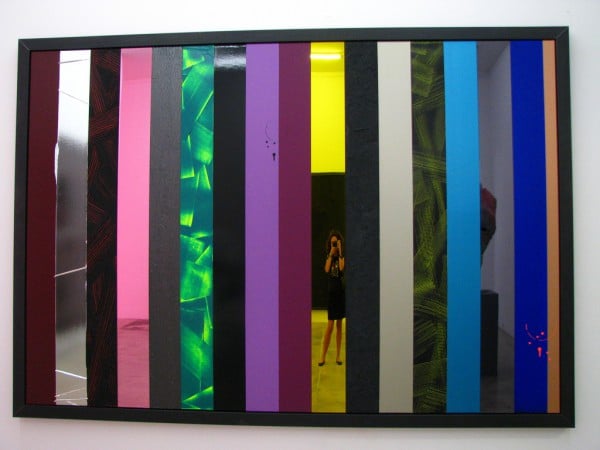
In 2008, works by Anselm Reyle grossed US$6,018,097 at auction. Last year, despite the art market reaching new heights as if the crash had never occurred, his auction tally narrowly topped US$2 million. With perhaps the exception of Hirst’s Dot Paintings or diamond-encrusted skull, For the Love of God (2007), one would be hard pressed to better sum up the pre-crash aesthetic and penchant for speculation than with one of Reyle’s monumental canvases bedecked with shiny, bright colored foil, sometimes crinkled, sometimes laid down in stripes. Since 2001, Reyle has produced these works and other flashtastic neons, polished metal sculptures, and paint-by-numbers canvases in a factory-like studio overlooking Berlin’s Spree River.
However, that studio is soon to shut its doors. In an interview with German daily Die Welt, the artist announced an open-ended hiatus from art production. Citing promising gallery sales in recent years, Reyle claims his motivations were more personal than financial. But considering that, according to Reyle, the studio enterprise’s total costs ranged from €150,000-800,000 (approx. US$ 205,000-1.1 million) per month, it’s understandable the artist might want to put things on hold while building a new home and storage facility with his wife, architect Tanja Lincke.
The notoriously opaque realm of gallery sales aside (Reyle’s Berlin dealer, CFA, did not respond to artnet’s request for comment), auction demand for the artist’s works remains slack at best, with only a slight uptick in sales to $2.17 million in 2013, from $1.53 million in 2012. Reyle’s story is much more a cautionary tale against fulfilling feverish early demand for work that comes hand in hand with rampant speculation — he tells Die Welt that collectors could practically have foil works made to order at his peak —than any sort of qualitative referendum by the market on the work. If anything, a slacking of that demand right now due to a feeling that they are gauche will only strengthen their long term position of being so spot-on in their reflection of the capital frenzy of the early-aughts.
Whatever the rationale, the numbers are clear. Reyle’s overall value according to arnet Analytics’ most recent index report is down to an all-time low of only 31% of its peak value, which occurred in 2008, just two years after his work entered the secondary market. In the meantime, while the artnet Contemporary 50 and S&P500 indices fell 40% and 22%, respectively, to their lows in 2009, both have rebounded to sit today at 147% of their 2008 values.
Reyle’s sell-through rate at auction tells a similar story. While a below average showing of one 61% in 2009 can more or less be cast aside due to the sluggish market worldwide that year, it’s in 2012 that the artist saw the least interest in offerings of his work at auction, with just 19 of 40 works offered, or 48% finding successful bidders. However, demand, if not his price point, does appear to be rising once again. Over the past year, Reyle’s sell-through rate jumped back to 73%, just 2.25 points behind his lifetime average.
For those who speculated early on a Reyle that was bound to line their coffers with more than gold foil, the results are fairly grim, however. The year 2013 saw his lowest-ever average price ($72,429) and average high estimate ($72,340)—figures that have consistently tracked in step with one another other than during the 2007 auction season—since any significant stream of works hit the auction market. (The figures were lower in 2006, at $57,896 and $64,947, respectively, but only one work was available.) Despite his self proclaimed lack of market intent with the studio closure, the move could see these numbers rise again due to perceived scarcity of supply going forward but only time will tell. Either way, one wouldn’t expect there to be much movement in his all-time top performing 5 or even 10 auction lots in the near future.